
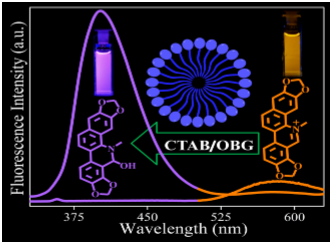
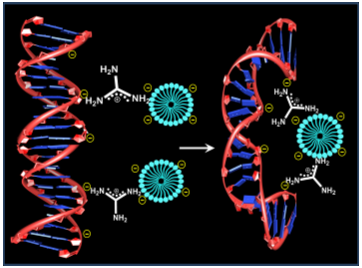
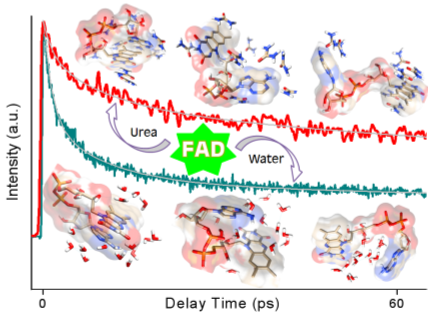
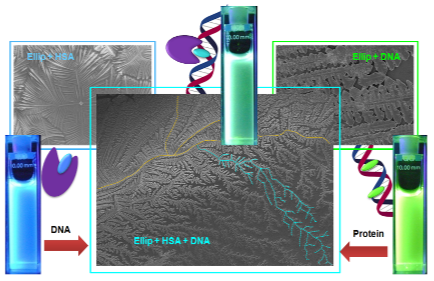
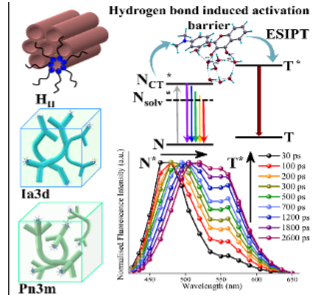
|
Research |

|
TCSPC set-up. |


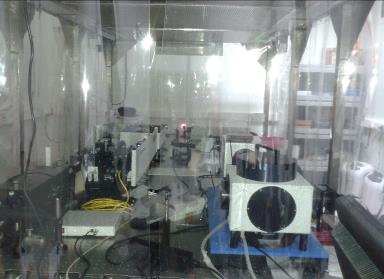
|
Mai-Tai Coupled Femtosecond up-conversion and TCSPC set-up. |
|
Femtosecond up-conversion set-up. |
|
Femtosecond up-conversion set-up. |

|
Present Research Interests
Spectroscopy of Materials:
v Design, Synthesis and Photophysics of Novel Thermally Activated Delayed Fluorescence (TADF), MR-TADF and Mechanochromic Fluorescent Luminogens:
In the field of organic light-emitting diodes (OLEDs), thermally activated delayed fluorescence (TADF) emitters have been emerged as a potential candidate for efficient harvesting of triplet excitons from the lowest triplet (T1) excited state to the lowest singlet (S1) excited state via reverse intersystem crossing (RISC), induced by thermal activation. In spite of multiple reports on TADF molecules in the last decade, the development and design of efficient TADF emitters still remain as a challenge. The main reason for this is, simultaneous achievement of smaller value along with a larger fluorescence radiative decay rate in one molecule is inherently difficult through molecular designing. In this project, we plan to carry out the synthesis, charcaterizations followed by photophysical studies of some novel thermally activated delayed fluorescence (TADF), which will exhibit nearly 100% internal luminescence quantum efficiency. Moreover, we are trying to achieve narrow band gap organic fluorophores using the concept of multi-resonance TADF (MR-TADF).
v Design, Synthesis and Photophysics of Small Organic Molecule based Persistent Room Temperature Phosphorescent (RTP) Luminogens:
Research interest in organic materials with persistent room temperature phosphorescence (RTP) is burgeoning topic of interest among scientific community. Organic phosphorescent materials with attractive properties such as long afterglow lifetimes, low cost, and processability, are outstanding candidates for bio-imaging, optical waveguides, organic light-emitting diodes (OLEDs), and security printing. However, purely organic materials often suffer from weak spin orbit coupling (SOC), which is essential to promote the intersystem crossing (ISC) process necessary for phosphorescence. Our group presently focusing of designing and synthesising novel organic luminogens, which can exhibit persistent RTP in 100 of millisecond to second time-scale.
v Synthesis, Optical Properties and Ultrafast Dynamics of Luminescent Copper Dinuclear Complexes and Chain Clusters:
Copper(I) dinuclear complexes and chain clusters of copper having suitable ligands are attractive photo-functional materials due to their rich photochemical and photophysical properties. It has been proved that these new materials have potential application in many fields , such as organic light-emit ting diodes, optical sensor, nonlinear optics and dye sensitized solar cells. In our group, we are trying to design and synthesize novel dinculear complexes and chain clusters, so that they can be used triplet harvesting materials, which is utmost important for its applications towards various application. Moroever, we are trying to understand their excited state properties using time-resolved fluorescence and other pump-probe techniques.
Biophysics:
v Designing of Novel Fluorophores for Probing Amyloid Fibril:
Misfolding of amyloidogenic protein results the deposition of protein agglomerates in different part of human body, and are believed to be involved in the pathology of amyloidosis, such as Alzheimer disease, Parkinson disease, Prion diseases, type II diabetes etc. Several small organic molecules have been designed for the optical imaging of amyloid fibrils. Most of the cases the detection is based on the enhancement of fluorescence intensity of the probes. However, such intensity-based or fluorescent turn on probes are always susceptible to self-quenching at higher concentrations, making the fluorophores unsuitable for quantitative analysis. Moreover, using such fluorescent turn on probe, it is hard to investigate the detail mechanism of fibril formation as they only reports on the formation of final fibrillar state, and does not reveal the presence of oligomers or other types of aggregates. Thus, instead of monitoring the fibrillation by a single intensity-based, it would be very simple and effective if one can monitor this fibril formation process directly by the switch in the fluorescence color of the probes. In continuation of this effort, here we are going to introduce a series of donor acceptor-based charge transfer probe molecules, which forms AIE dots in buffer, and able to sense insulin amyloid fibrils in terms of disaggregation induced fluorescence switching and fluorescence enhancement.
v Conformational Transition and Stabilization of Non-canonical Forms of DNA, i.e., G-quadruplex, i-motif:
The primary motivation of the works is to control and detect the conformational transition between different secondary structures of DNA, which will be advantageous in terms of their participation in different biologically important processes. Structural characteristics of these different DNA forms will be utilized to modulate their conformational transitions by some external stimuli, which will give us an excellent opportunity to understand the molecular mechanism behind the formation and stabilization of these different DNA structures.
|
|
Important Published Works |
|
Welcome to Dr. Partha Hazra Group |
|
Professor in Chemistry
|


|
The present study shows that a special class of ionic liquid (Gua-IL) can act as a stabilizer of telomeric GQ-DNA exerting minimal effect towards the duplex structure and thereby can be considered as a potential telomerase inhibitor. Phys. Chem. Chem. Phys., 2016, 18, 29740-29746. |
|
Dual fluorescence property of an eminent anticancer drug, ellipticine, has been explored to directly monitor its efficient loading into MCM-41 and subsequent release to DNA. Nanoscale, 2016, 8, 18436-18445. |

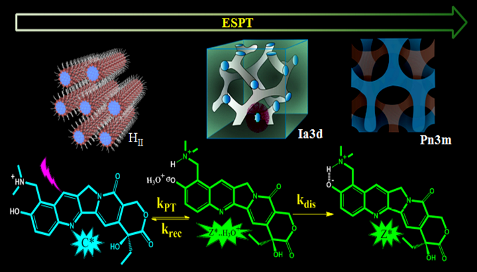
|
Investigation of Photopyrolytic Processes of an Anticancer Drug Topotecan inside Biocompatible Lyotropic Liquid Crystalline Systems. Langmuir, 2016, 32, 3057-3065. |

|
An antimalerial/anticancer drug, Cryptolepine is encapsulated inside the nano-cavity of cucurbit[7]uril, and its subsequent release to DNA is monitored using an external stimulus, acetylcholine chloride. ChemPhysChem, 2016, 17, 506-515. |


|
Solvation dynamics has been investigated in different Phases of lyotropic liquid crystalline systems. J. Phys. Chem. B, 2015, 119, 11721-11731. |
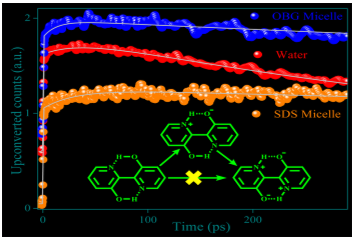

|
Femtosecond Up-conversion Studies of [2,2-Bipyridyl]-3,3-diol in Octyl-β-D-glucoside and Other Micellar Aggregates. J. Phys. Chem. A, 2015, 119, 12715-12721. |
|
Fluorescence Switching of Sanguinarine in Micellar Environments. Phys. Chem. Chem. Phys. 2015, 17, 20725-20732. |

|
An ionic liquid induced Green Solvent Induced DNA Package. Scientific Reports, 2015, 5, Article number: 9137. |
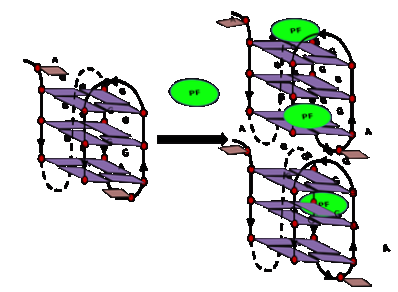
|
Biophysical aspects of binding interactions between anticancer drug, Proflavine and human telomeric DNA have been monitored with different spectroscopic techniques. We have observed that Proflavine instigates and stabilizes the G-quadruplex DNA.J. Phys. Chem. B, 2014, 118, 11090-11099 |
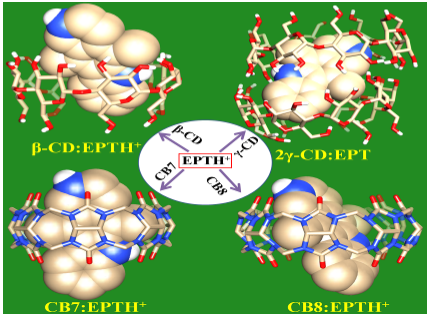

|
Prototropical and photophysical properties of an anti-cancer drug, EPT are explored inside the inclusion complexes formed by cyclodextrins and cucurbit[n]urils using spectroscopic and computational studies. J. Phys. Chem. B, 2013, 117, 14099-14107. |


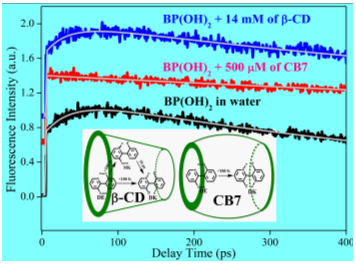
|
The effect of physical nanocavity on double proton transfer dynamics of BP(OH)2 is studied from femtosecond to nanosecond regime using TCSPC and fluorescence upconversion techniques. Phys. Chem. Chem. Phys. 2014, 16 (3), 933 - 939. |
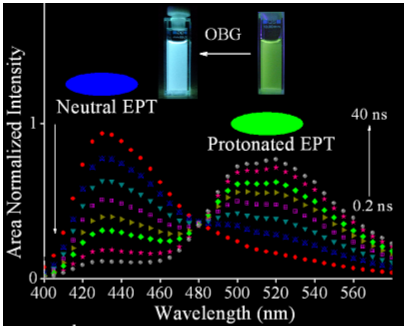

|
Prototropical and photophysical properties of an anticancer drug, ellipticine are explored inside the octyl-b-D-glucoside micelles using steady state and time resolved spectroscopic techniques. Phys. Chem. Chem. Phys. 2014, 16, 14953-14960. |
|
Urea Induced Unfolding dynamics of Flavin Adenine Dinucleotide (FAD): Spectroscopic And Molecular Dynamics Simulation Studies from Femto-second to Nano-second regime. J. Phys. Chem. B, 2014, 118, 1881-1890. |

|
A clearly visible emission color switching of an anti-cancer drug, ellipticine in presence of protein (blue), DNA (green) and protein-DNA system (sea green) promotes a novel technique to probe protein-DNA interaction. Phys. Chem. Chem. Phys. 2014, 16, 3914-3917. |

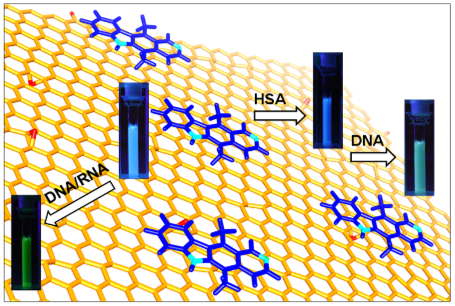
|
Dual fluorescence property of an eminent anticancer drug, ellipticine, has been explored to directly monitor its efficient loading onto graphene oxide and subsequent release to biomolecules like DNA/RNA. Nanoscale, 2014, 6, 2937-2944. |

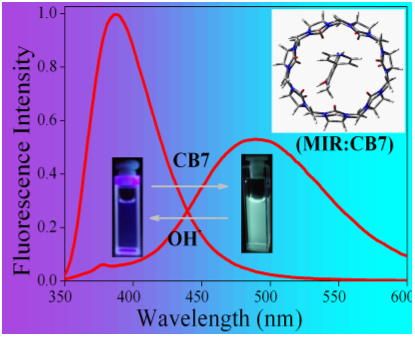
|
A fluorescence switch from ultraviolet (UV) to visible (cyan) is observed as a consequence of upward pKa shift of milrinone inside the CB7 nano-cavity. Phys. Chem. Chem. Phys. 2014, 16(7), 2823-2826. |

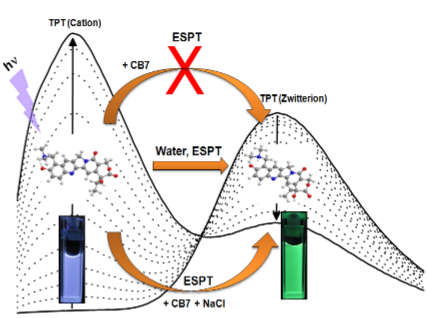
|
Inside the nano-cavity of CB7, ESPT of TPT is inhibited and fluorescence switches from green to blue (see picture). When NaCl is introduced into the TPT-CB7 solution, the blue colour switches back to green. ChemPhysChem, 2013, 14 3375-3383. |


|
ESPT dynamics of a potential anti-cancer drug, Topotecan has been explored in aqueous reverse micelle using steady-state and time-resolved fluorescence measurements. J. Phys. Chem. B, 2015, 119, 2363-2371. |

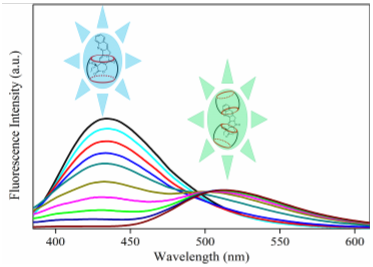
|
Cucurbit[7]uril (C7U) assists the pKa shift of an anticancer drug, 20(S)-camptothecin (CPT) by forming 2:1 (C7U:CPT) inclusion complex. However, the protonation does not take place when it is encased by β-cyclodextrin cavity. ChemPhysChem 2013, 14, 532. |

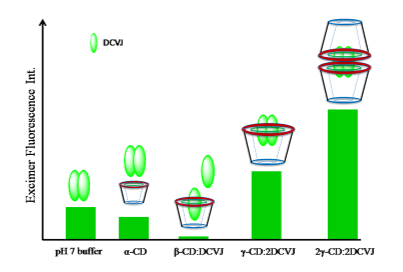
|
The modulation over excimer formation drift of a molecular motor, called DCVJ, have been probed inside various cavity sizes of cyclodextrins host. Phys. Chem. Chem. Phys. 2013, 15, 330 |

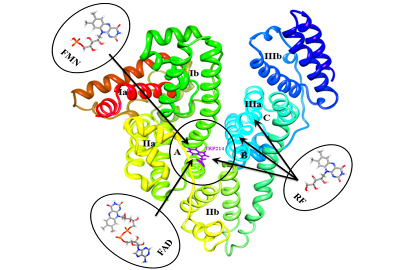
|
The binding interactions of flavins (riboflavin (RF), flavin adenine dinucleotide (FAD) and flavin mononucleotide (FMN)) with HSA have been monitored with the help of steady state and time-resolved fluorescence spectroscopy, isothermal titration calorimetry, circular dichroism studies, and supported by docking and molecular dynamics (MD) simulations studies. ChemPhysChem. 2012, 13, 2142-2153. |

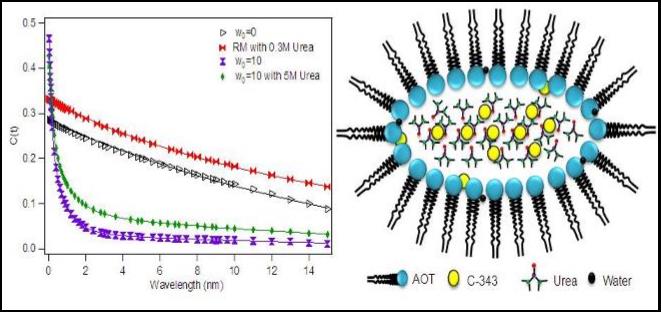
|
In this work the urea dynamics inside AOT reverse micelle has been monitored without intervention of water using time resolved fluorescence techniques from picosecond to nanosecond time regime. Urea dynamics inside the reverse micelle is severely hindered compared to dry as well as water RM due to the formation of highly networked molecular cluster of urea. J. Phys. Chem. A, 2011, 115, 10398-10407. |

|
We have studied the solvation dynamics and rotational relaxation of Coumarin 153 (C-153) in SDS dispersed two different types of single walled carbon nanotubes (SWNTs), namely metallic and semiconducting, using picosecond fluorescence spectroscopy. Chem. Phys. Lett., 2010, 501, 33-38. |


|
Hydrogen Bonding Abilities of LLC Water Molecules and their Effects on Intramolecular Hydrogen Bonds of Target Probe Molecules. PCCP, 2020, 22, 6210-6221. |


|
Impact of Topology on the Characteristics of Water inside Cubic Lyotropic Liquid Crystalline Systems. J. Phys. Chem. B, 2019, 123, 18, 4118-4128. |

|
A new approach has been explored to detect i-motif DNA structures based on the hemi-protonated cytosine-cytosine (C+-C) base pairing recognition instead of conventional loop detection of i-motif DNA. Along with its selectivity towards i-motif DNA over its complimentary GQ DNA, this approach shows its versatility by detecting different kind of i-motif structures with different chain lengths, molecularity and sizes etc. Organic & Biomolecular Chemistry (OBC) 2019, 17, 5392-5399. |


|
Strategy to Mechanical Activation of Centro-Symmetrically Packed Organic Luminogens. J. Phys. Chem. C, 2019, 123, 3848-3854. |
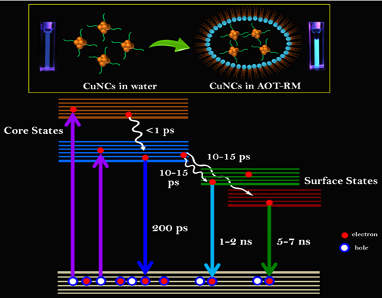
|
Ultrafast Fluorescence Dynamics of Highly Stable Copper Nanoclusters Synthesized inside the Aqueous Nano-pool of Reverse Micelles. J. Phys. Chem. C, 2018, 122, 5742-5752 . |
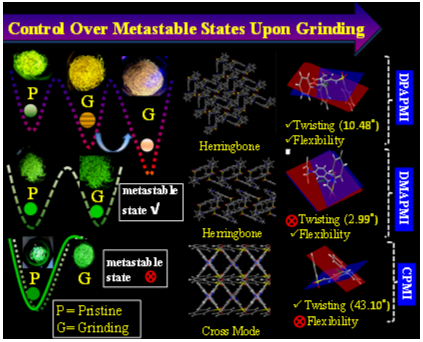
|
Developing Structure-Property Relationship to Design Solid State Multi-stimuli Responsive Materials and Their Potential Applications in Different Fields. Chemical Science, 2018, 9, 3592-3606. |




|
A new approach has been explored to instigate the formation and stabilization of i-motif DNA at neutral and alkaline medium by means of incorporating into mesoporous silica nano-channels (MCM-41). Additionally, this i-motif DNA formation has been controlled using positively charged lysozyme protein which drags the DNA from the nano-pore followed by protein-DNA complex formation. Chemical Communications, 2018, 54 (51), 7054-7057 . |




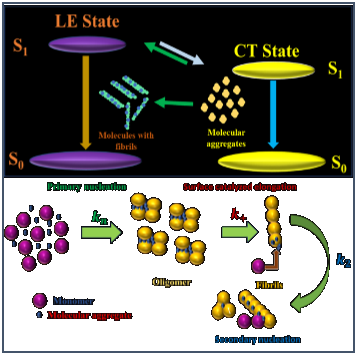
|
This study demonstrates that our organic dots can be used for the imaging, the early stage detection of amyloid fibril formation and the modulation of amyloid formation pathway. Nanoscale, 2020, 12, 16805-16818. |

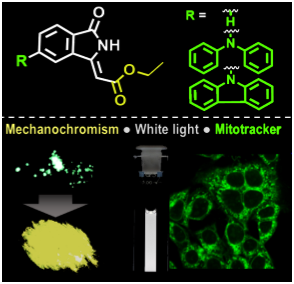
|
In this work, we have reported an all in one type single source white light emitter with mito-tracking ability and stimuli responsive behavior. J. Phys. Chem. Lett. 2021, 12, 1162. |

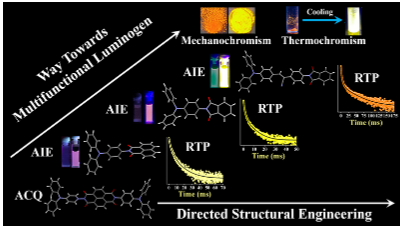
|
In this work, we have shown a strategy to achieve aggregation induced emission (AIE), room temperature phosphorescence (RTP) and multi-stimuli response from a single organic luminogen through directed structural engineering. J. Phys. Chem. B, 2021, 125, 12832-12846. |
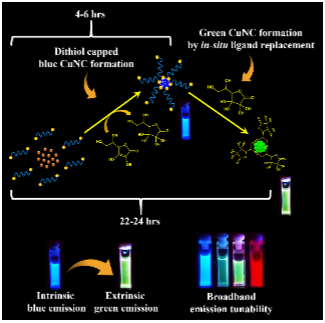
|
Broadband emission tunability in thiol protected Cu nanoclusters has been achieved through in-situ ligand engineering, where the reducing agent plays the key role. Phys. Chem. Chem. Phys., 2021, 25850-25865. |
|
In this work, we have probed proton coupled electron transfer (PCET) inside the aqueous nano-channels of liquid crystals. J. Phys. Chem. Lett. 2021, 12, 2651-2659. |




|
This work provided a structure-property relationship to achieve effective harvestation of triplet excitons in iodide-bridged rhombic Cu2I2 complexes, and their effective utilization in OLED device fabrication and non-linear photon up-conversion processes. J. Phys. Chem. Lett. 2024, 15, 6069. |

|
Tuning of TADF efficiency of three donor-acceptor based organic molecules was carried out using a regio-isomeric approach. Chemical Science, 2023, 14, 13832-13841. |

